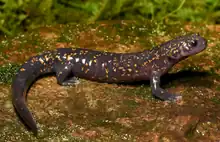| Asiatic salamanders Temporal range: | |
|---|---|
 | |
| Hynobius fossigenus | |
| Scientific classification | |
| Domain: | Eukaryota |
| Kingdom: | Animalia |
| Phylum: | Chordata |
| Class: | Amphibia |
| Order: | Urodela |
| Suborder: | Cryptobranchoidea |
| Family: | Hynobiidae Cope, 1859 |
| Genera | |
|
Batrachuperus | |
The Asiatic salamanders (family Hynobiidae) are primitive salamanders found all over Asia, and in European Russia. They are closely related to the giant salamanders (family Cryptobranchidae), with which they form the suborder Cryptobranchoidea. About half of hynobiids currently described are endemic to Japan.[1]
Hynobiid salamanders practice external fertilization, or spawning. And, unlike other salamander families which reproduce internally, male hynobiids focus on egg sacs rather than females during breeding.[2] The female lays two egg sacs at a time, each containing up to 70 eggs. Parental care is common.[3]
A few species have very reduced lungs, or no lungs at all. Larvae can sometimes have reduced external gills if they live in cold and very oxygen-rich water.[4]
Fossils of hynobiids are known from the Miocene to the present in Asia and Eastern Europe, though fossils of Cryptobranchoids more closely related to hynobiids than to giant salamanders extend back to the Middle Jurassic.[5]
Phylogeny
Cladograms based on the work of Pyron and Wiens (2011)[6] and modified using Mikko Haaramo [7]
| ||||||||||||||||||||||||||||||||||||||||||||||||||||||||||
Classification
Currently, 81 species are known. These genera make up the Hynobiidae:
Subfamily Hynobiinae
- Genus Afghanodon
- Afghanodon mustersi (Smith, 1940)
- Genus Batrachuperus (Chinese stream salamanders)
- Batrachuperus karlschmidti Liu, 1950
- Batrachuperus londongensis Liu and Tian, 1978
- Batrachuperus pinchonii (David, 1872)
- Batrachuperus tibetanus Schmidt, 1925
- Batrachuperus yenyuanensis Liu, 1950
- Genus Hynobius - (Asian salamanders)
- Hynobius abei Sato, 1934
- Hynobius abuensis Matsui, Okawa, Nishikawa, and Tominaga, 2019
- Hynobius akiensis Matsui, Okawa, and Nishikawa, 2019
- Hynobius amakusaensis Nishikawa and Matsui, 2014
- Hynobius amjiensis Gu, 1992
- Hynobius arisanensis Maki, 1922
- Hynobius bakan Matsui, Okawa, and Nishikawa, 2019
- Hynobius boulengeri (Thompson, 1912)
- Hynobius chinensis Günther, 1889
- Hynobius dunni Tago, 1931
- Hynobius formosanus Maki, 1922
- Hynobius fossigenus Okamiya, Sugawara, Nagano, and Poyarkov, 2018
- Hynobius fucus Lai and Lue, 2008
- Hynobius glacialis Lai and Lue, 2008
- Hynobius guabangshanensis Shen, 2004
- Hynobius guttatus Tominaga, Matsui, Tanabe, and Nishikawa, 2019
- Hynobius hidamontanus Matsui, 1987
- Hynobius hirosei Lantz, 1931
- Hynobius ikioi Matsui, Nishikawa, and Tominaga, 2017
- Hynobius iwami Matsui, Okawa, Nishikawa, and Tominaga, 2019
- Hynobius katoi Matsui, Kokuryo, Misawa, and Nishikawa, 2004
- Hynobius kimurae Dunn, 1923
- Hynobius kuishiensis Tominaga, Matsui, Tanabe, and Nishikawa, 2019
- Hynobius leechii Boulenger, 1887
- Hynobius lichenatus Boulenger, 1883
- Hynobius maoershanensis Zhou, Jiang, and Jiang, 2006
- Hynobius mikawaensis Matsui, Misawa, Nishikawa, and Shimada, 2017
- Hynobius naevius (Temminck and Schlegel, 1838)
- Hynobius nebulosus (Temminck and Schlegel, 1838)
- Hynobius nigrescens Stejneger, 1907
- Hynobius okiensis Sato, 1940
- Hynobius osumiensis Nishikawa and Matsui, 2014
- Hynobius oyamai Tominaga, Matsui, and Nishikawa, 2019
- Hynobius quelpaertensis Mori, 1928
- Hynobius retardatus Dunn, 1923
- Hynobius sematonotos Tominaga, Matsui, and Nishikawa, 2019
- Hynobius setoi Matsui, Tanabe, and Misawa, 2019
- Hynobius setouchi Matsui, Okawa, Tanabe, and Misawa, 2019
- Hynobius shinichisatoi Nishikawa and Matsui, 2014
- Hynobius sonani (Maki, 1922)
- Hynobius stejnegeri Dunn, 1923
- Hynobius takedai Matsui and Miyazaki, 1984
- Hynobius tokyoensis Tago, 1931
- Hynobius tosashimizuensis Sugawara, Watabe, Yoshikawa, and Nagano, 2018
- Hynobius tsuensis Abé, 1922
- Hynobius tsurugiensis Tominaga, Matsui, Tanabe, and Nishikawa, 2019
- Hynobius turkestanicus Nikolskii, 1910
- Hynobius unisacculus Min, Baek, Song, Chang, and Poyarkov, 2016
- Hynobius utsunomiyaorum Matsui and Okawa, 2019
- Hynobius vandenburghi Dunn, 1923
- Hynobius yangi Kim, Min, and Matsui, 2003
- Hynobius yiwuensis Cai, 1985
- Genus Liua (Wushan salamanders)
- Liua shihi (Liu, 1950)
- Liua tsinpaensis (Liu and Hu, 1966)
- Genus Pachyhynobius (stout salamanders)
- Pachyhynobius shangchengensis Fei, Qu, and Wu, 1983
- Genus Paradactylodon (Middle Eastern stream salamanders)
- Paradactylodon persicus (Eiselt and Steiner, 1970)
- Genus Pseudohynobius
- Pseudohynobius flavomaculatus (Hu and Fei, 1978)
- Pseudohynobius guizhouensis Li, Tian, and Gu, 2010
- Pseudohynobius jinfo Wei, Xiong, and Zeng, 2009
- Pseudohynobius kuankuoshuiensis Xu and Zeng, 2007
- Pseudohynobius puxiongensis (Fei and Ye, 2000)
- Pseudohynobius shuichengensis Tian, Gu, Li, Sun, and Li, 1998
- Genus Ranodon (Semirichensk salamanders)
- Ranodon sibiricus Kessler, 1866
- Genus Salamandrella (Siberian salamanders)
- Salamandrella keyserlingii Dybowski, 1870
- Salamandrella tridactyla Nikolskii, 1905
Subfamily Onychodactylinae
- Genus Onychodactylus (clawed salamanders)
- Onychodactylus fischeri (Boulenger, 1886)
- Onychodactylus fuscus Yoshikawa and Matsui, 2014
- Onychodactylus intermedius Nishikawa and Matsui, 2014
- Onychodactylus japonicus (Houttuyn, 1782)
- Onychodactylus kinneburi Yoshikawa, Matsui, Tanabe, and Okayama, 2013
- Onychodactylus koreanus Min, Poyarkov, and Vieites, 2012
- Onychodactylus nipponoborealis Kuro-o, Poyarkov, and Vieites, 2012
- Onychodactylus tsukubaensis Yoshikawa and Matsui, 2013
- Onychodactylus zhangyapingi Che, Poyarkov, and Yan, 2012
- Onychodactylus zhaoermii Che, Poyarkov, and Yan, 2012
References
- ↑ (Hasumi 2002).
- ↑ (Hasumi, 2002).
- ↑ Lanza, B.; Vanni., S. & Nistri, A. (1998). Cogger, H.G. & Zweifel, R.G. (eds.). Encyclopedia of Reptiles and Amphibians. San Diego: Academic Press. p. 69. ISBN 0-12-178560-2.
- ↑ Hasumi, M. (2002). About hynobiids. Retrieved May 8, 2005 from .
- ↑ Jia, Jia; Anderson, Jason S.; Gao, Ke-Qin (2021-07-23). "Middle Jurassic stem hynobiids from China shed light on the evolution of basal salamanders". iScience. 24 (7): 102744. doi:10.1016/j.isci.2021.102744. ISSN 2589-0042. PMC 8264161. PMID 34278256.
- ↑ Pyron, R.A.; Weins, J.J. (2011). "A large-scale phylogeny of Amphibia including over 2800 species, and a revised classification of advanced frogs, salamanders, and caecilians" (PDF). Molecular Phylogenetics and Evolution. 61 (2): 543–853. doi:10.1016/j.ympev.2011.06.012. PMID 21723399.
- ↑ Haaramo, Mikko (2011). "Caudata – salamanders". Mikko's Phylogeny Archive.
External links
 Data related to Hynobiidae at Wikispecies
Data related to Hynobiidae at Wikispecies- AmphibiaWeb: Hynobiidae
- Tree of Life: Hynobiidae
- livingunderworld.org
